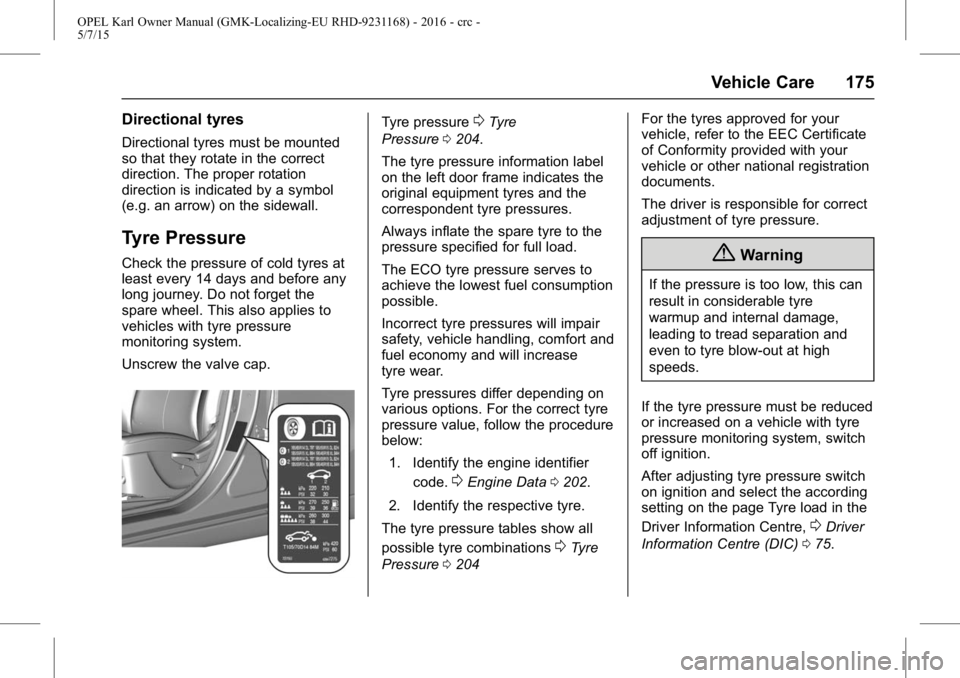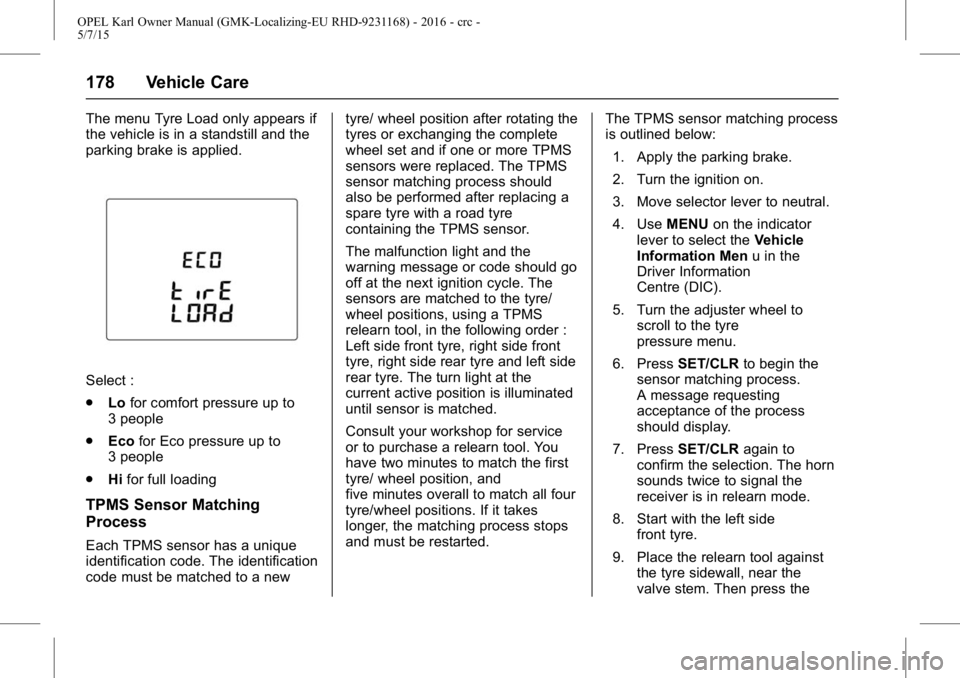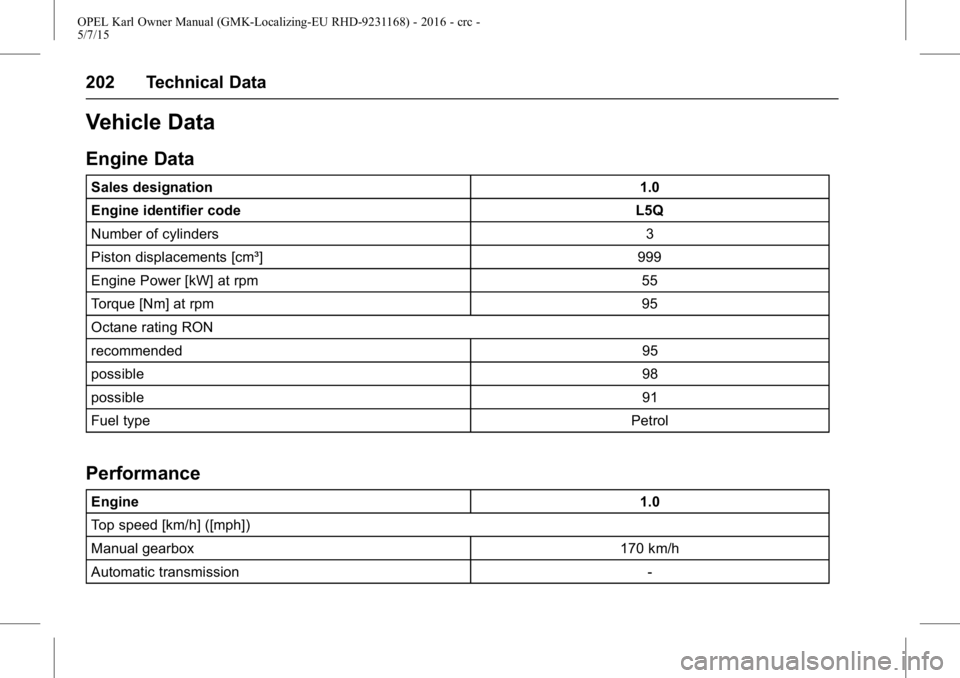code 21 OPEL KARL 2015 User Guide
[x] Cancel search | Manufacturer: OPEL, Model Year: 2015, Model line: KARL, Model: OPEL KARL 2015Pages: 217, PDF Size: 4.16 MB
Page 176 of 217

OPEL Karl Owner Manual (GMK-Localizing-EU RHD-9231168) - 2016 - crc -
5/7/15
Vehicle Care 175
Directional tyres
Directional tyres must be mounted
so that they rotate in the correct
direction. The proper rotation
direction is indicated by a symbol
(e.g. an arrow) on the sidewall.
Tyre Pressure
Check the pressure of cold tyres at
least every 14 days and before any
long journey. Do not forget the
spare wheel. This also applies to
vehicles with tyre pressure
monitoring system.
Unscrew the valve cap.
Tyre pressure0Tyre
Pressure 0204.
The tyre pressure information label
on the left door frame indicates the
original equipment tyres and the
correspondent tyre pressures.
Always inflate the spare tyre to the
pressure specified for full load.
The ECO tyre pressure serves to
achieve the lowest fuel consumption
possible.
Incorrect tyre pressures will impair
safety, vehicle handling, comfort and
fuel economy and will increase
tyre wear.
Tyre pressures differ depending on
various options. For the correct tyre
pressure value, follow the procedure
below: 1. Identify the engine identifier code.
0Engine Data 0202.
2. Identify the respective tyre.
The tyre pressure tables show all
possible tyre combinations
0Tyre
Pressure 0204 For the tyres approved for your
vehicle, refer to the EEC Certificate
of Conformity provided with your
vehicle or other national registration
documents.
The driver is responsible for correct
adjustment of tyre pressure.
{Warning
If the pressure is too low, this can
result in considerable tyre
warmup and internal damage,
leading to tread separation and
even to tyre blow-out at high
speeds.
If the tyre pressure must be reduced
or increased on a vehicle with tyre
pressure monitoring system, switch
off ignition.
After adjusting tyre pressure switch
on ignition and select the according
setting on the page Tyre load in the
Driver Information Centre,
0Driver
Information Centre (DIC) 075.
Page 179 of 217

OPEL Karl Owner Manual (GMK-Localizing-EU RHD-9231168) - 2016 - crc -
5/7/15
178 Vehicle Care
The menu Tyre Load only appears if
the vehicle is in a standstill and the
parking brake is applied.
Select :
.Lofor comfort pressure up to
3 people
. Eco for Eco pressure up to
3 people
. Hifor full loading
TPMS Sensor Matching
Process
Each TPMS sensor has a unique
identification code. The identification
code must be matched to a new tyre/ wheel position after rotating the
tyres or exchanging the complete
wheel set and if one or more TPMS
sensors were replaced. The TPMS
sensor matching process should
also be performed after replacing a
spare tyre with a road tyre
containing the TPMS sensor.
The malfunction light and the
warning message or code should go
off at the next ignition cycle. The
sensors are matched to the tyre/
wheel positions, using a TPMS
relearn tool, in the following order :
Left side front tyre, right side front
tyre, right side rear tyre and left side
rear tyre. The turn light at the
current active position is illuminated
until sensor is matched.
Consult your workshop for service
or to purchase a relearn tool. You
have two minutes to match the first
tyre/ wheel position, and
five minutes overall to match all four
tyre/wheel positions. If it takes
longer, the matching process stops
and must be restarted.
The TPMS sensor matching process
is outlined below:
1. Apply the parking brake.
2. Turn the ignition on.
3. Move selector lever to neutral.
4. Use MENUon the indicator
lever to select the Vehicle
Information Men u in the
Driver Information
Centre (DIC).
5. Turn the adjuster wheel to scroll to the tyre
pressure menu.
6. Press SET/CLR to begin the
sensor matching process.
A message requesting
acceptance of the process
should display.
7. Press SET/CLR again to
confirm the selection. The horn
sounds twice to signal the
receiver is in relearn mode.
8. Start with the left side front tyre.
9. Place the relearn tool against the tyre sidewall, near the
valve stem. Then press the
Page 180 of 217

OPEL Karl Owner Manual (GMK-Localizing-EU RHD-9231168) - 2016 - crc -
5/7/15
Vehicle Care 179
button to activate the TPMS
sensor. A horn chirp confirms
that the sensor identification
code has been matched to this
tyre and wheel position.
10. Proceed to the right side front tyre, and repeat the procedure
in Step 9.
11. Proceed to the right side rear tyre, and repeat the procedure
in Step 9.
12. Proceed to the left side rear tyre, and repeat the procedure
in Step 9. The horn sounds
twice to indicate the sensor
identification code has been
matched to the left side rear
tyre, and the TPMS sensor
matching process is no longer
active.
13. Turn off the ignition.
14. Set all four tyres to the recommended air pressure
level as indicated on the tyre
pressure label. 15. Ensure the tyre loading status
is set according selected
pressure
0Driver Information
Centre (DIC) 075.
Temperature dependency
The tyre pressure depends on the
temperature of the tyre. During
driving, tyre temperature and
pressure increase. Tyre pressure
values provided on the tyre
information label and tyre pressure
chart are valid for cold tyres, which
means at 20 °C. The pressure
increases by nearly 10 kPa for a
10 °C temperature increase. This
must be considered when warm
tyres are checked.
The tyre pressure value displayed in
the DIC shows the real tyre
pressure. A cooled down tyre will
show a decreased value, which
does not indicate an air leak.
Tread Depth
Check tread depth at regular
intervals. Tyres should be replaced for safety
reasons at a tread depth of 2-3 mm
(4 mm for winter tyres).
For safety reasons it is
recommended that the tread depth
of the tyres on one axle should not
vary by more than 2 mm.
The legally permissible minimum
tread depth (1.6 mm) has been
reached when the tread has worn
down as far as one of the tread
wear indicators (TWI). Their position
is indicated by markings on the
sidewall.
Page 201 of 217

OPEL Karl Owner Manual (GMK-Localizing-EU RHD-9231168) - 2016 - crc -
5/7/15
200 Technical Data
Technical Data
Vehicle Identification
Vehicle IdentificationNumber (VIN) . . . . . . . . . . . . . . . 200
Engine Identification . . . . . . . . . . 200
Identification Plate . . . . . . . . . . . . 201
Vehicle Data
Engine Data . . . . . . . . . . . . . . . . . . 202
Performance . . . . . . . . . . . . . . . . . 202
Vehicle Weight . . . . . . . . . . . . . . . 203
Vehicle Dimensions . . . . . . . . . . 203
Capacities and Specifications . . . . . . . . . . . . . . . 204
Tyre Pressure . . . . . . . . . . . . . . . . 204
Vehicle Identification
Vehicle Identification
Number (VIN)
The Vehicle Identification Number is
located in the engine compartment.
The Vehicle Identification Number
may be embossed on the instrument
panel, visible through the
windscreen.
Engine Identification
The technical data tables show the
engine identifier code. Engine data
0Engine Data 0202.
To identify the respective engine,
refer to the engine power in the
EEC Certificate of Conformity
provided with your vehicle or other
national registration documents.
Page 203 of 217

OPEL Karl Owner Manual (GMK-Localizing-EU RHD-9231168) - 2016 - crc -
5/7/15
202 Technical Data
Vehicle Data
Engine Data
Sales designation1.0
Engine identifier code L5Q
Number of cylinders 3
Piston displacements [cm³] 999
Engine Power [kW] at rpm 55
Torque [Nm] at rpm 95
Octane rating RON
recommended 95
possible 98
possible 91
Fuel type Petrol
Performance
Engine 1.0
Top speed [km/h] ([mph])
Manual gearbox 170 km/h
Automatic transmission -